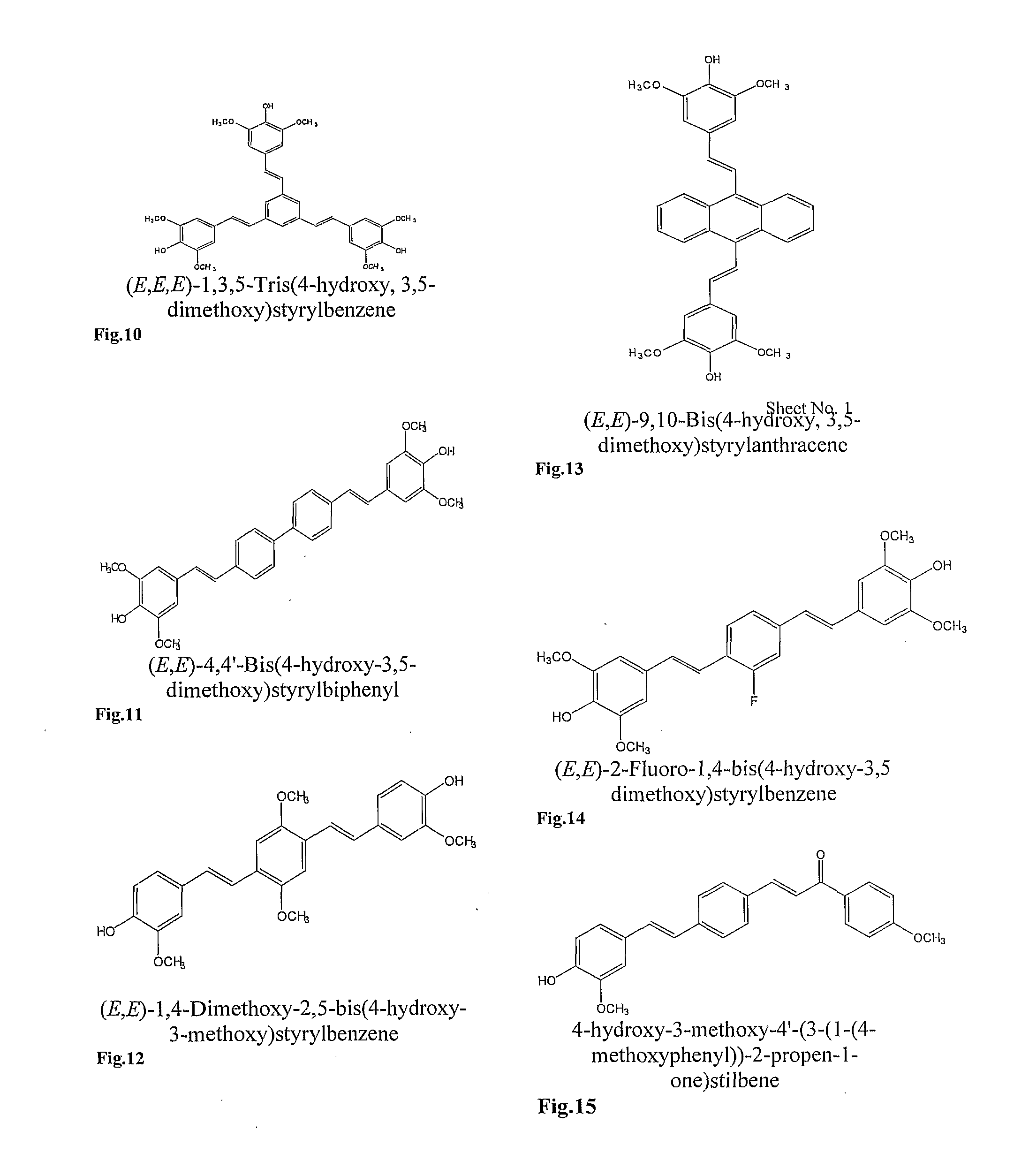One pot multicomponent synthesis of some novel hydroxy stilbene derivatives with alpha, beta-carbonyl conjugation under microwave irradiation
a technology of hydroxy stilbene and alpha-beta-carbonyl, which is applied in the preparation of carbonyl compounds, organic chemistry, plant/algae/fungi/lichens ingredients, etc., can solve the problems of low yield of stilbene derivatives, and achieve the effects of low cost, low cost, and low side product yield
- Summary
- Abstract
- Description
- Claims
- Application Information
AI Technical Summary
Benefits of technology
Problems solved by technology
Method used
Image
Examples
example i
Synthesis of 4-hydroxy-3,4′-dimethoxy stilbene
Under Monomode Microwave
[0080](from formula I where R3═OH, R4═R3═OMe, R1, R2, R3, R5, R6, R9, R10═H):
[0081]A mixture of 4-hydroxy-3-methoxybenzaldehyde (3.42 mmol), malonic acid (13.68 mmol), para-iodo anisole (1.9 mmol), palladium acetate (0.076 mmol), triphenylphosphine (0.089 mmol), piperidine (15.58 mmol) and DMF (20 ml) were taken in a 100 ml round bottom flask fitted with a condenser. The flask was shaken well and placed inside the monomode microwave oven and irradiated (250 W, 160° C.) for 30 minutes in parts. After completion, the reaction mixture was poured in ice cooled water and extracted with ethyl acetate. The organic layer was washed with dil. HCl, brine and water and dried over sodium sulphate. The solvent was evaporated under reduced pressure to obtain liquid which was purified on silica gel by column chromatography using a mixture of hexane and ethyl acetate (9:1 to 6:4), provided a white solid; 40% yield (m.p. 163-166° ...
example ii
Synthesis of 4-hydroxy-3,4′-dimethoxy stilbene
Using Recyclable Palladium Nanoparticle and in Absence of Toxic Triphenyl Phosphine
[0082](from formula I where R3═OH, R4═R3═OMe, R1, R2, R3, R5, R6, R9, R10═H):
[0083]Palladium acetate (0.1 mmol) was added to a rapidly stirring solution of PEG (0.75 mmol) taken in a 100 ml round bottom flask and the contents were subsequently heated at 80° C. for 2 hours. The heating was stopped after 2 hours with the formation of brown palladium nanoparticles. The mixture was allowed to cool to room temperature. A mixture of 4-hydroxy-3-methoxybenzaldehyde (3.42 mmol), malonic acid (13.68 mmol), para-iodo anisole (1.9 mmol), palladium nanoparticles (0.078 mmol), piperidine (15.58 mmol) and DMF (20 ml) were taken in a 100 ml round bottom flask fitted with a condenser. The flask was shaken well and placed inside the monomode microwave oven and irradiated (250 W, 160° C.) for 30 minutes in parts. After completion, the reaction mixture was extracted with die...
example iii
Synthesis of 4-hydroxy-3,4′-dimethoxy stilbene
Under Conventional Heating
[0084](from formula I where R3═OH, R4═R8═OMe, R1, R2, R3, R5, R6, R9, R10═H):
[0085]A mixture of 4-hydroxy-3-methoxybenzaldehyde (3.42 mmol), malonic acid (13.68 mmol), para-iodoanisole (1.9 mmol), palladium acetate (0.076 mmol), triphenylphosphine (0.089 mmol), piperidine (15.58 mmol) and DMF (25 ml) were taken in a 100 ml round bottom flask and refluxed the mixture. After completion, the reaction was worked up as in example I and provided a white solid; 35% yield (m.p. 163-166° C.); 1H NMR (CDCl3) 7.36 (2H, d), 6.94 (2H, m), 6.83 (5H, m), 5.59 (1H, s), 3.86 (3H, s), 3.75 (3H, s); 13C NMR (CDCl3) 159.0, 146.7, 145.2, 130.3, 127.4, 126.6, 126.1, 120.1, 114.5, 114.1, 108.0, 55.9 and 55.3.
PUM
| Property | Measurement | Unit |
|---|---|---|
| Temperature | aaaaa | aaaaa |
| Temperature | aaaaa | aaaaa |
| Power | aaaaa | aaaaa |
Abstract
Description
Claims
Application Information
 Login to View More
Login to View More - R&D
- Intellectual Property
- Life Sciences
- Materials
- Tech Scout
- Unparalleled Data Quality
- Higher Quality Content
- 60% Fewer Hallucinations
Browse by: Latest US Patents, China's latest patents, Technical Efficacy Thesaurus, Application Domain, Technology Topic, Popular Technical Reports.
© 2025 PatSnap. All rights reserved.Legal|Privacy policy|Modern Slavery Act Transparency Statement|Sitemap|About US| Contact US: help@patsnap.com



